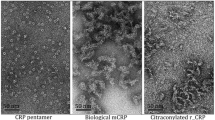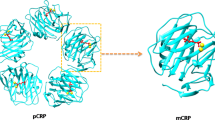Summary
The relation between the expression and activity of MMP-9 in C-reactive protein (CRP)-induced human THP-1 mononuclear cells and the activation of nuclear factor kappa-B (NF-κB) was studied to investigate the possible role of CRP in plaque destabilization. Human THP-1 cells were incubated in the presence of CRP at 0 (control group), 25, 50 and 100 μg/mL (CRP groups) for 24 h. In PDTC (a specific NF-κB inhibitor) group, the cells were pre-treated with PDTC at 10 μmol/L and then with 100 μg/mL CRP. The conditioned media (CM) and human THP-1 cells in different groups were harvested. MMP-9 expression in CM and human THP-1 cells was measured by ELISA and Western blotting. MMP-9 activity was assessed by fluorogenic substrates. The expression of NF-κB inhibitor α (IκB-α) and NF-κB P65 was detected by Western blotting and ELISA respectively. The results showed that CRP increased the expression and activity of MMP-9 in a dose-dependent manner in the human THP-1 cells. Western blotting revealed that IκB-α expression was decreased in the cells with the concentrations of CRP and ELISA demonstrated that NF-κB P65 expression in the CRP-induced cells was increased. After pre-treatment of the cells with PDTC at 10 μmol/L, the decrease in IκB-α expression and the increase in NF-κB P65 expression in the CRP-induced cells were inhibited, and the expression and activity of MMP-9 were lowered too. It is concluded that increased expression and activity of MMP-9 in CRP-induced human THP-1 cells may be associated with activation of NF-κB. Down-regulation of the expression and activity of MMP-9 may be a new treatment alternative for plaque stabilization by inhibiting the NF-κB activation.
Similar content being viewed by others
References
Libby P. Inflammation in atherosclerosis. Nature, 2002, 420(6917):868–874
Zebrack JS, Muhlestein JB, Horne BD, et al. C-reactive protein and angiographic coronary artery disease: independent and additive predictors of risk in subjects with angina. J Am Coll Cardiol, 2002,39(4):632–637
Lindahl B, Toss H, Siegbahn A, et al. Markers of myocardial damage and inflammation in relation to long-term mortality in unstable coronary artery disease. FRISC Study Group. Fragmin during Instability in Coronary Artery Disease. N Engl J Med, 2000,343(16):1139–1147
Retterstol L, Eikvar L, Bohn M, et al. C-reactive protein predicts death in patients with previous premature myocardial infarction: a 10-year follow-up study. Atherosclerosis, 2002,160(2):433–440
Ridker PM, Rifai N, Rose L, et al. Comparison of C-reactive protein and low-density lipoprotein cholesterol levels in the prediction of first cardiovascular events. N Engl J Med, 2002,347(20):1557–1565
Burke AP, Tracy RP, Kolodgie F, et al. Elevated C-reactive protein values and atherosclerosis in sudden coronary death: association with different pathologies. Circulation, 2002,105(17):2019–2023
Williams TN, Zhang CX, Game BA, et al. C-reactive protein stimulates MMP-1 expression in U937 histiocytes through FcγRII and extracellular signal-regulated kinase pathway: an implication of CRP involvement in plaque destabilization. Arterioscler Thromb Vasc Biol, 2004, 24(1):61–66
Nabata A, Kuroki M, Ueba H, et al. C-reactive protein induces endothelial cell apoptosis and matrix metalloproteinase-9 production in human mononuclear cells: Implications for the destabilization of atherosclerotic plaque. Atherosclerosis, 2008,196(1):129–135
Blaschke F, Bruemmer D, Yin F, et al. C-reactive protein induces apoptosis in human coronary vascular smooth muscle cells. Circulation, 2004,110(5):579–587
Bellosta S, Via D, Canavesi M, et al. HMG-CoA reductase inhibitors reduce MMP-9 secretion by macrophages. Arterioscler Thromb Vasc Biol, 1998,18(11):1671–1678
de Winther MP, Kanters E, Kraal G, et al. Nuclear factor κB signaling in atherogenesis. Arterioscler Thromb Vasc Biol, 2005,25(5):904–914
Jialal I, Devaraj S. The role of C-reactive protein activation of nuclear factor Kappa-B in the pathogenesis of unstable angina. J Am Coll Cardiol, 2007,49(2):195–197
Liuzzo G, Santamaria M, Biasucci LM, et al. Persistent activation of nuclear factor kappa-B signaling pathway in patients with unstable angina and elevated levels of C-reactive protein: evidence for a direct proinflammatory effect of azide and lipopolysaccharide-free C-reactive protein on human monocytes via nuclear factor Kappa-B activation. J Am Coll Cardiol, 2007,49(2):185–194
Montero I, Orbe J, Varo N, et al. C-reactive protein induces matrix metalloproteinase-1 and -10 in human endothelial cells: implications for clinical and subclinical atherosclerosis. J Am Coll Cardiol, 2006,47(7): 1369–1378
Loftus IM, Naylor AR, Goodall S, et al. Increased matrix metalloproteinase-9 activity in unstable carotid plaques: a potential role in acute plaque disruption. Stroke, 2000, 31(1):40–47
Schonbeck U, Libby P. Inflammation, immunity, and HMG-CoA reductase inhibitors: statins as anti-inflammatory agents? Circulation, 2004,109(21 Suppl 1):II18–26
Abe N, Osanai T, Fujiwara T, et al. C-reactive protein-induced upregulation of extracellular matrix metalloproteinase inducer in macrophages: Inhibitory effect of fluvastatin. Life Sci, 2006, 78(9):1021–1028
Ho TY, Yan WB, Bagnell CA. Relaxin-induced matrix metalloproteinase-9 expression is associated with activation of the NF-κB pathway in human THP-1 cells. J Leukoc Biol, 2007,81(5):1303–1310
He C. Molecular mechanism of transcriptional activation of human gelatinase B by proximal promoter. Cancer Lett,1996,106(2):185–191
Schreck R, Rieber P, Baeuerle PA. Reactive oxygen intermediates as apparently widely used messengers in the activation of the NF-κB transcription factor and HIV-1. EMBO J, 1991,10(8):2247–2258
Author information
Authors and Affiliations
Rights and permissions
About this article
Cite this article
Sheng, F., Cheng, L., Zeng, Q. et al. Increased expression and activity of MMP-9 in C-reactive protein- induced human THP-1 mononuclear cells is related to activation of nuclear factor kappa-B. J. Huazhong Univ. Sci. Technol. [Med. Sci.] 29, 399–403 (2009). https://doi.org/10.1007/s11596-009-0401-0
Received:
Published:
Issue Date:
DOI: https://doi.org/10.1007/s11596-009-0401-0




